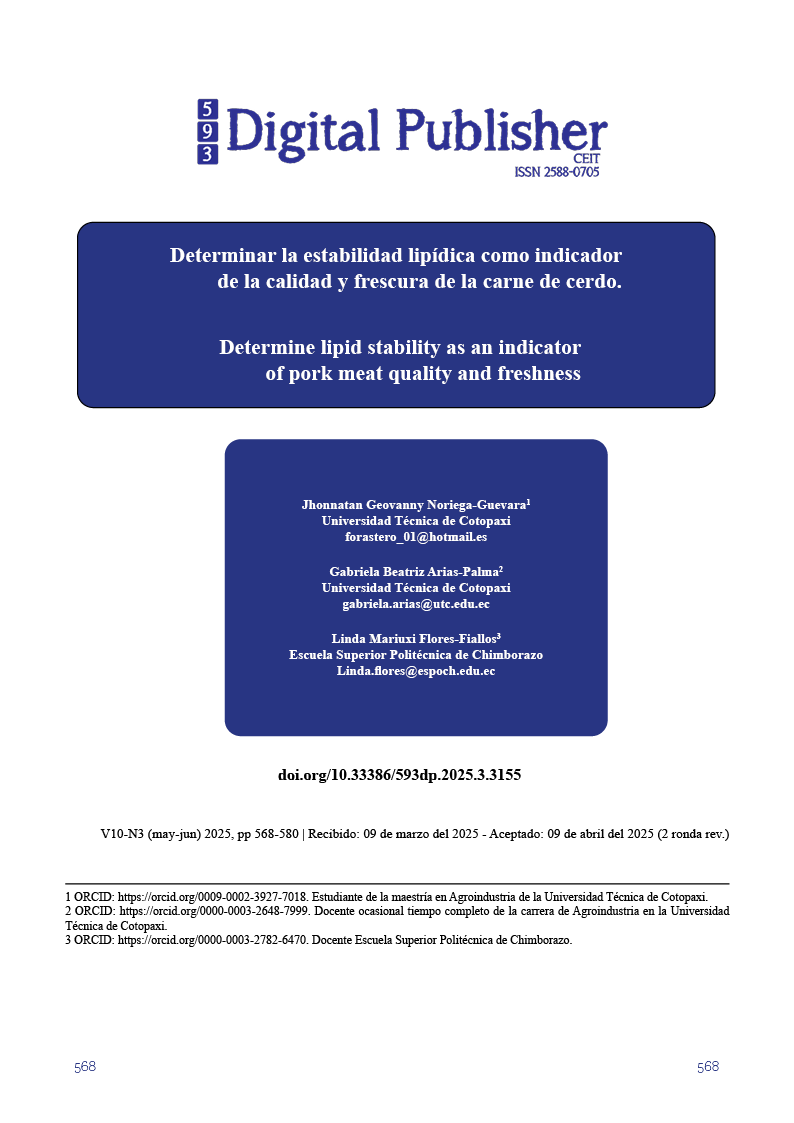Determine lipid stability as an indicator of pork meat quality and freshness
Main Article Content
Abstract
The present study aimed to determine lipid stability as an indicator of pork quality and freshness, evaluating the effects of different storage conditions and times. A completely randomized factorial experimental design was used with two factors: storage conditions (4°C and -18°C) and storage times (0, 7, 14, 21 and 28 days), applying analytical techniques to measure rancidity indices and microbial load in samples obtained from the San Alfonso market in Riobamba. Peroxide Index (PI) analyses indicated that no significant changes were observed in lipid oxidation in samples stored at -18°C and 4°C during the first 21 days, remaining below 0.3 mEq O₂/kg. However, TBARS analysis showed that chilled meat experienced a 79.92% increase in oxidative rancidity within 21 days, while frozen meat only had a 12.58% increase. Microbiological analyses revealed a 215% increase in microbial load in chilled meat, with no E. coli or Salmonella spp. detected in any sample. It is concluded that freezing at -18°C is the best strategy to preserve lipid quality and reduce microbial growth, while refrigeration at 4°C should be limited to less than two weeks to avoid accelerated deterioration. In addition, the use of vacuum packaging and antioxidant preservatives is recommended to prolong shelf life and maintain the sensory quality of the product.
Downloads
Article Details

This work is licensed under a Creative Commons Attribution-NonCommercial-ShareAlike 4.0 International License.
1. Derechos de autor
Las obras que se publican en 593 Digital Publisher CEIT están sujetas a los siguientes términos:
1.1. 593 Digital Publisher CEIT, conserva los derechos patrimoniales (copyright) de las obras publicadas, favorece y permite la reutilización de las mismas bajo la licencia Licencia Creative Commons 4.0 de Reconocimiento-NoComercial-CompartirIgual 4.0, por lo cual se pueden copiar, usar, difundir, transmitir y exponer públicamente, siempre que:
1.1.a. Se cite la autoría y fuente original de su publicación (revista, editorial, URL).
1.1.b. No se usen para fines comerciales u onerosos.
1.1.c. Se mencione la existencia y especificaciones de esta licencia de uso.
References
Ahmad, A., Mahmood, N., Hussain, M., Aiman, U., Al-Mijalli, S., & Raza, M. (2023). Improvement in oxidative stability and quality characteristics of functional chicken meat product supplemented with aqueous coriander extract. Int J Food Prop, 26, 855–65. doi:10.1080/10942912.2023.2189086
Al-Shibli, M., Hashim, A., & Ali, R. (2023). Evaluation of meat and meat product oxidation and off-flavor formation: Managing oxidative changes. Theory and practice of meat processing, 8(4), :302-315. doi:10.21323/2414-438X-2023-8-4-302-315
Amaral, A., Silva, M., & Lannes, S. (2018). Lipid oxidation in meat: mechanisms and protective factors – a review. Food Sci. Technol, Campinas, 38, 1-15. https://www.scielo.br/j/cta/a/3ZDMTNLBZ63pGz3DgsbyS7h/?format=pdf&lang=en
Catalán, V., & Gómez, J. (2018). Inflammatory and Oxidative Stress Markers in Skeletal. Clinica Universidad de Navarra. doi:10.1016/B978-0-12-812504-5.00008-8
Coombs, C., Holman, B., Ponnampalam, E., Morris, S., Friend, M., & Hopkins, D. (2019). Effects of chilled and frozen storage conditions on the lamb M. longissimus lumborum fatty acid and lipid oxidation parameters. Meat Sci., 136, 116–122.
Domínguez, R., Pateiro, M., Gagaoua, M., Barba, F., Zhang, W., & Lorenzo, J. (2019). A Comprehensive Review on Lipid Oxidation in Meat and Meat Products. Antioxidants (Basel), 8(10). https://www.ncbi.nlm.nih.gov/pmc/articles/PMC6827023/
Equipo de Expertos en Ciencias de la Salud. (.7 de 07 de 2021). Control de calidad de alimentos. ¿En qué consiste? Universidad Internacional de Valencia.
Feng, X., Li, J., Zhang, L., Rao, Z., Feng, S., Wang, Y., & Liu, H. (2022). Integrated Lipidomic and Metabolomics Analysis Revealing the Effects of Frozen Storage Duration on Pork Lipids. Metabolites, 12(10), 977. https://doi.org/10.3390/metabo12100977
Graciano, M., Rodríguez, J., Sumaya, M., & Balois, R. (2022). Efecto de extractos naturales sobre la estabilidad oxidativa de hamburguesas de carne de cerdo durante el almacenamiento refrigerado. Revista mexicana de ciencias pecuarias, 13(2). https://www.scielo.org.mx/scielo.php?script=sci_arttext&pid=S2007-11242022000200323#B2
Innovad. (2020). Innovad Create Trust. Obtenido de https://innovadglobal.com/es/conservacion-de-alimentos
Instituto Ecuatoriano de Normalización. (2016). NTE INEN 776:2016. Calidad del agua – Muestreo para análisis microbiológico.
Instituto Ecuatoriano de Normalización. (2016). INEN 1529-2. Análisis microbiológico del agua – Parte 2: Métodos para la enumeración de organismos coliformes y Escherichia coli – Método del número más probable (NMP).
Instituto Ecuatoriano de Normalización. (2016). Norma Técnica Ecuatoriana NTE INEN 2346 Carne y menudencias comestibles de animales de abasto. Requisitos.
Ko, C., Qu, J., Black, D., & Tso, P. (2020). Regulation of intestinal lipid metabolism: Current concepts and relevance to disease. Nat. Rev. Gastroenterol. Hepatol., 17, 169–183.
Muzolf, M., Kaczmarek, A., Tomaszewska, J., Cegielska, R., & Majcher, M. (2019). Oxidative and microbiological stability of raw ground pork during chilled storage as affected by Plant extracts. International Journal of Food Properties, 22(1), 111–129. https://doi.org/10.1080/10942912.2019.1579834
Ramírez, M., Vargas, R., Torres, B., Torrescano, G., Lorenzo, J., & Sánchez, A. (2019). Inclusion of Ethanol Extract of Mesquite Leaves to Enhance the Oxidative Stability of Pork Patties. Foods, 8(12). https://doi.org/10.3390/foods8120631
Reitznerová, A., Sulekova, M., Nagy, J., Marcincák, S., Semjon, B., Certík, M., & Klempová, T. (2017). Lipid Peroxidation Process in Meat and Meat Products: A Comparison Study of Malondialdehyde Determination between Modified 2-Thiobarbituric Acid Spectrophotometric Method and Reverse-Phase High-Performance Liquid Chromatography. Molecules, 22(11). https://www.ncbi.nlm.nih.gov/pmc/articles/PMC6150165/
Tatiyabor, N., Oz, F., Richards, M., & Wu, H. (2022). Paradoxical effects of lipolysis on the lipid oxidation in meat and meat products. Food Chem., 14(100317).
Wang, D., Xiao, H., Lyu, X., Chen, H., & Wei, F. (2023). Lipid oxidation in food science and nutritional health: a comprehensive review. Oil Crop Sci., 8, 35–44. doi:10.1016/j.ocsci.2023.02.002
Zhou, B., Luo, J., Quan, W., Lou, A., & Shen, Q. (2023). Antioxidant activity and sensory quality of bacon. Foods. Front. Nutr., 11(366). doi:10.3390/foods11020236




